High-Performance Thin-Layer Chromatography (HPTLC) Method for Identification of Meloxicam and Piroxicam
Abstract
:1. Introduction
2. Materials and Methods
2.1. Apparatus
- CAMAG Limomat 5, a software-controlled applicator CAMAG, Muttenz, Switzerland);
- CAMAG Automatic Developing Chamber 2 (CAMAG, Muttenz, Switzerland);
- CAMAG TLC Visualizer 2 (CAMAG, Muttenz, Switzerland);
- Ultrasonic bath (BANDELIN, Berlin, Germany).
2.2. Pharmaceutical Reference Standards and Chemicals
2.3. Standard Solutions and Sample Preparation
2.4. Chromatography
3. Results and Discussion
3.1. Method Development
3.2. Method Validation
3.3. Determination of Meloxicam and Piroxicam in Commercial Formulations
3.4. Advantages and Limitations of the Proposed Method
4. Conclusions
Author Contributions
Funding
Institutional Review Board Statement
Informed Consent Statement
Data Availability Statement
Conflicts of Interest
References
- Srivastava, M.M. An Overview of HPTLC: A Modern Analytical Technique with Excellent Potential for Automation, Optimization, Hyphenation, and Multidimensional Applications. In High-Performance Thin-Layer Chromatography (HPTLC); Srivastava, M., Ed.; Springer: Berlin/Heidelberg, Germany, 2011; pp. 3–24. ISBN 978-3-642-14024-2. [Google Scholar]
- Variyar, P.S.; Chatterjee, S.; Sharma, A. Fundamentals and Theory of HPTLC-Based Separation. In High-Performance Thin-Layer Chromatography (HPTLC); Srivastava, M., Ed.; Springer: Berlin/Heidelberg, Germany, 2011; pp. 27–39. ISBN 978-3-642-14024-2. [Google Scholar]
- Patel, R.B.; Patel, M.R.; Batel, B.G. Experimental Aspects and Implementation of HPTLC. In High-Performance Thin-Layer Chromatography (HPTLC); Srivastava, M., Ed.; Springer: Berlin/Heidelberg, Germany, 2011; pp. 41–54. ISBN 978-3-642-14024-2. [Google Scholar]
- Charegaonkar, D. High-Performance Thin-Layer Chromatography: Excellent Automation. In High-Performance Thin-Layer Chromatography (HPTLC); Srivastava, M., Ed.; Springer: Berlin/Heidelberg, Germany, 2011; pp. 55–65. ISBN 978-3-642-14024-2. [Google Scholar]
- Parys, W.; Pyka-Pająk, A.; Dołowy, M. Application of Thin-Layer Chromatography in Combination with Densitometry for the Determination of Diclofenac in Enteric Coated Tablets. Pharmaceuticals 2019, 12, 183. [Google Scholar] [CrossRef] [PubMed] [Green Version]
- Fried, B.; Reddy, A. Recent High Performance Thin Layer Chromatographic Studies on Biomphalaria Glabrata (Gastropoda). Chromatography 2015, 2, 118–124. [Google Scholar] [CrossRef]
- Choma, I.; Jesionek, W. TLC-Direct Bioautography as a High Throughput Method for Detection of Antimicrobials in Plants. Chromatography 2015, 2, 225–238. [Google Scholar] [CrossRef]
- Orfali, R.; Perveen, S.; Aati, H.Y.; Alam, P.; Noman, O.M.; Palacios, J.; Al-Kurbi, B.S.S.; Al-Taweel, A.M.; Khan, A.; Mehmood, R.; et al. High-Performance Thin-Layer Chromatography for Rutin, Chlorogenic Acid, Caffeic Acid, Ursolic Acid, and Stigmasterol Analysis in Periploca Aphylla Extracts. Separations 2021, 8, 44. [Google Scholar] [CrossRef]
- Noman, O.M.; Nasr, F.A.; Mothana, R.A.; Alqahtani, A.S.; Qamar, W.; Al-Mishari, A.A.; Al-Rehaily, A.J.; Siddiqui, N.A.; Alam, P.; Almarfadi, O.M. Isolation, Characterization, and HPTLC-Quantification of Compounds with Anticancer Potential from Loranthus Acaciae Zucc. Separations 2020, 7, 43. [Google Scholar] [CrossRef]
- Bui, Q.; Sherma, J.; Hines, J. Using High Performance Thin Layer Chromatography-Densitometry to Study the Influence of the Prion [RNQ+] and Its Determinant Prion Protein Rnq1 on Yeast Lipid Profiles. Separations 2018, 5, 6. [Google Scholar] [CrossRef] [Green Version]
- Islam, M.K.; Sostaric, T.; Lim, L.Y.; Hammer, K.; Locher, C. Antioxidant HPTLC-DPPH Fingerprinting of Honeys and Tracking of Antioxidant Constituents upon Thermal Exposure. Foods 2021, 10, 357. [Google Scholar] [CrossRef]
- Binert-Kusztal, Ż.; Starek, M.; Żandarek, J.; Dąbrowska, M. Development of TLC Chromatographic-Densitometric Procedure for Qualitative and Quantitative Analysis of Ceftobiprole. Processes 2021, 9, 708. [Google Scholar] [CrossRef]
- Alam, P.; Shakeel, F.; Alqarni, M.H.; Foudah, A.I.; Faiyazuddin, M.D.; Alshehri, S. Rapid, Sensitive, and Sustainable Reversed-Phase HPTLC Method in Comparison to the Normal-Phase HPTLC for the Determination of Pterostilbene in Capsule Dosage Form. Processes 2021, 9, 1305. [Google Scholar] [CrossRef]
- Saslis-Lagoudakis, C.H.; Bruun-Lund, S.; Iwanycki, N.E.; Seberg, O.; Petersen, G.; Jäger, A.K.; Rønsted, N. Identification of Common Horsetail (Equisetum Arvense L.; Equisetaceae) Using Thin Layer Chromatography versus DNA Barcoding. Sci. Rep. 2015, 5, 11942. [Google Scholar] [CrossRef] [Green Version]
- Kaale, E.; Risha, P.; Layloff, T. TLC for Pharmaceutical Analysis in Resource Limited Countries. J. Chromatogr. A 2011, 1218, 2732–2736. [Google Scholar] [CrossRef] [PubMed]
- Elshafie, H.S.; Sadeek, S.A.; Zordok, W.A.; Mohamed, A.A. Meloxicam and Study of Their Antimicrobial Effects against Phyto- and Human Pathogens. Molecules 2021, 26, 1480. [Google Scholar] [CrossRef] [PubMed]
- Yu, Y.; Tian, Y.; Zhang, H.; Jia, Q.; Chen, X.; Kang, D.; Du, Y.; Song, S.; Zheng, A. The Evaluation of Meloxicam Nanocrystals by Oral Administration with Different Particle Sizes. Molecules 2022, 27, 421. [Google Scholar] [CrossRef] [PubMed]
- Gallo, M.; Serpella, L.; Leone, F.; Manna, L.; Banchero, M.; Ronchetti, S.; Onida, B. Piroxicam Loading onto Mesoporous Silicas by Supercritical CO2 Impregnation. Molecules 2021, 26, 2500. [Google Scholar] [CrossRef]
- Enthoven, W.T.; Roelofs, P.D.; Deyo, R.A.; van Tulder, M.W.; Koes, B.W. Non-Steroidal Anti-Inflammatory Drugs for Chronic Low Back Pain. Cochrane Database Syst. Rev. 2016, 2, CD012087. [Google Scholar] [CrossRef] [Green Version]
- Calvo, A.M.; Prado, M.T.D.O.; Dionísio, T.J.; Marques, M.P.; Brozoski, D.T.; Lanchote, V.L.; Faria, F.A.C.; Santos, C.F. Effective Method for the Detection of Piroxicam in Human Plasma Using HPLC. Braz. Oral Res. 2016, 30. [Google Scholar] [CrossRef] [Green Version]
- ICH Q2(R1) Validation of Analytical Procedures: Text and Methodology. Available online: https://www.gmp-compliance.org/files/guidemgr/Q2(R1).pdf (accessed on 7 January 2022).
- Puthli, S.P.; Vavia, P.R. Stability Indicating HPTLC Determination of Piroxicam. J. Pharm. Biomed. Anal. 2000, 22, 673–677. [Google Scholar] [CrossRef]
- Bartsch, H.; Eiper, A.; Kopelent-Frank, H. Stability Indicating Assays for the Determination of Piroxicam—Comparison of Methods. J. Pharm. Biomed. Anal. 1999, 20, 531–541. [Google Scholar] [CrossRef]
- Starek, M.; Krzek, J.; Tarsa, M.; Żylewski, M. Determination of Piroxicam and Degradation Products in Drugs by TLC. Chroma 2009, 69, 351–356. [Google Scholar] [CrossRef]
- Starek, M.; Krzek, J.; Rotkegel, P. TLC Determination of Piroxicam, Tenoxicam, Celecoxib and Rofecoxib in Biological Material. J. Anal. Chem. 2015, 70, 351–359. [Google Scholar] [CrossRef]
- Starek, M.; Krzek, J. TLC Determination of Meloxicam in Tablets and after Acidic and Alkaline Hydrolysis. Acta Pol. Pharm. 2012, 69, 225–235. [Google Scholar] [PubMed]
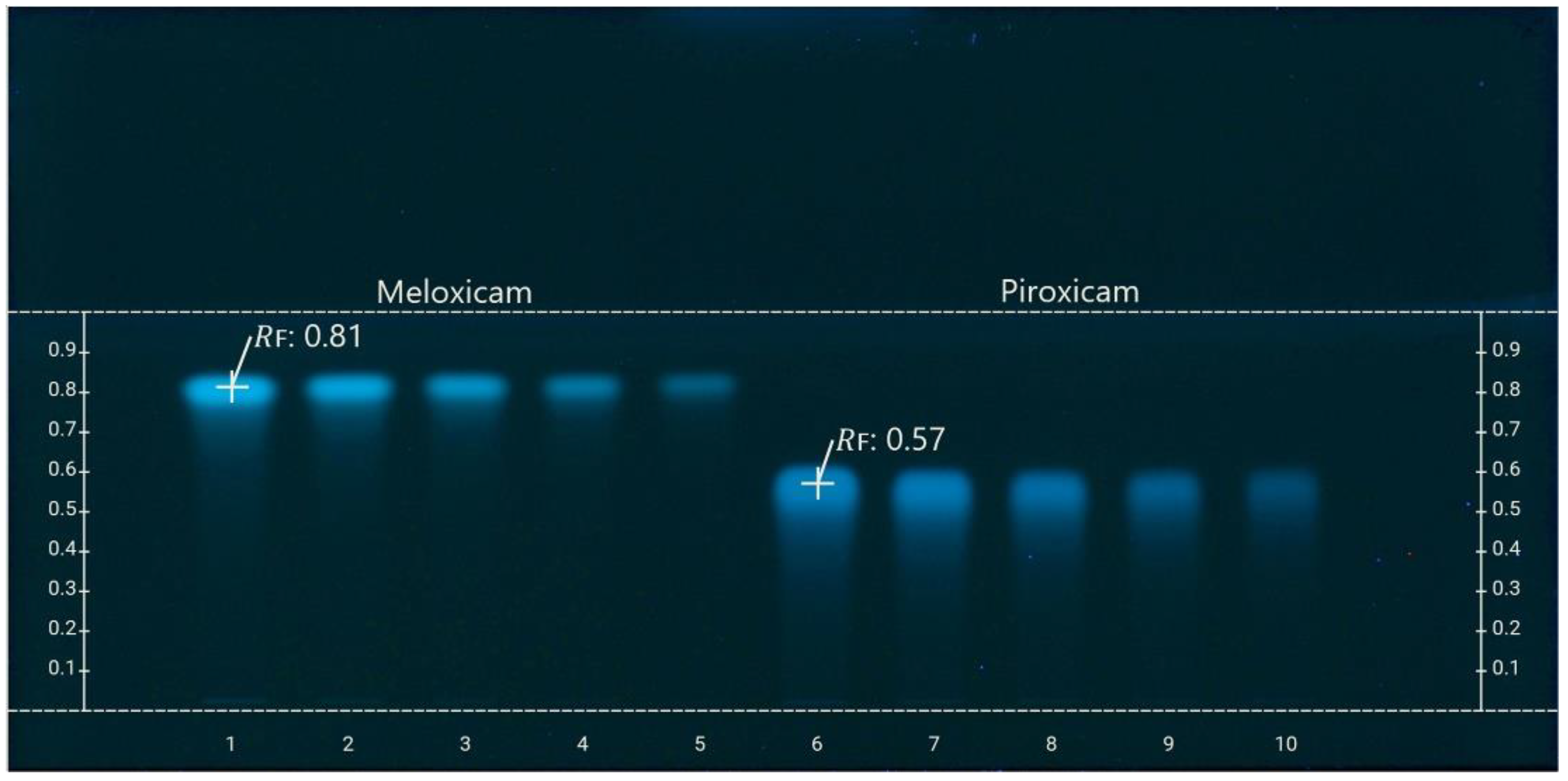
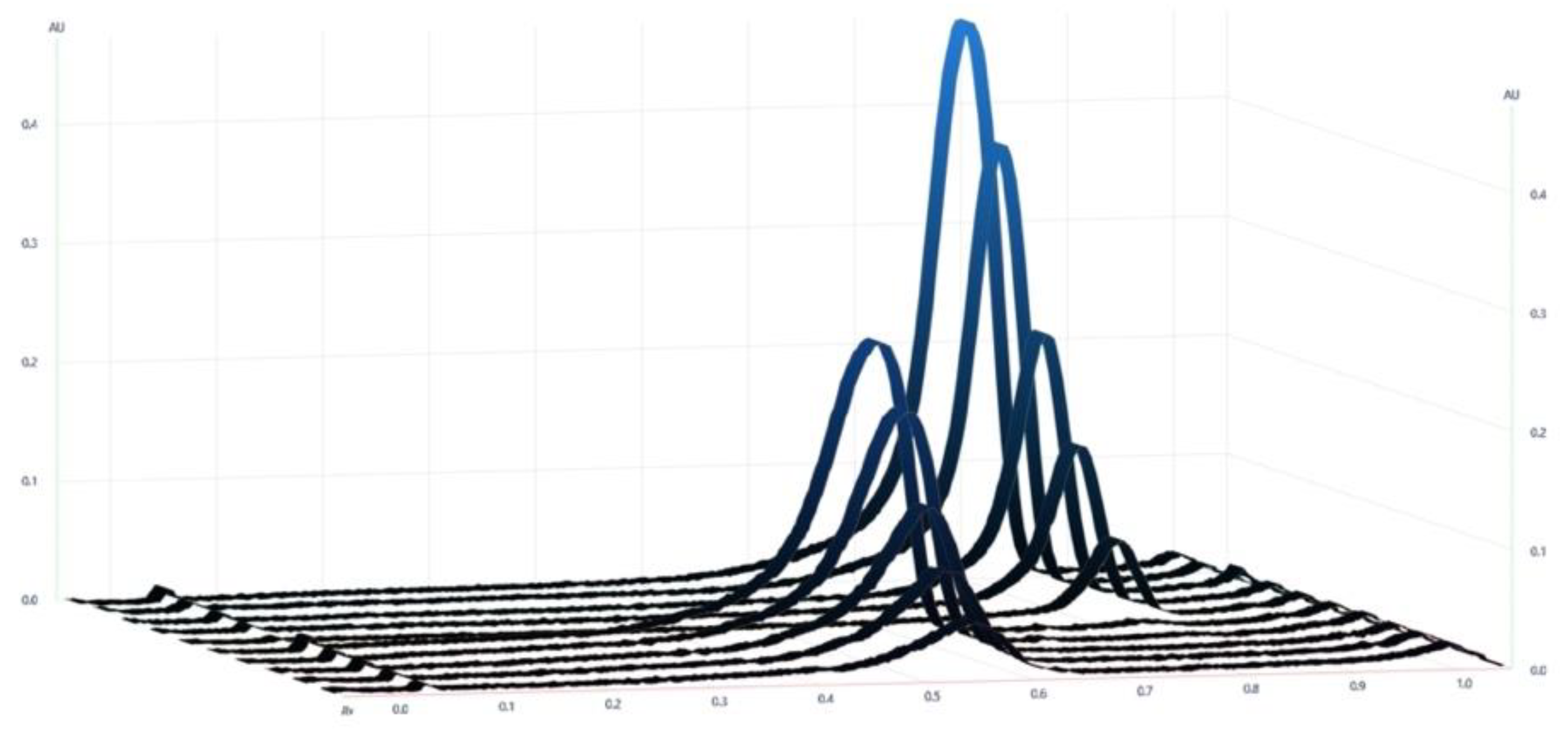
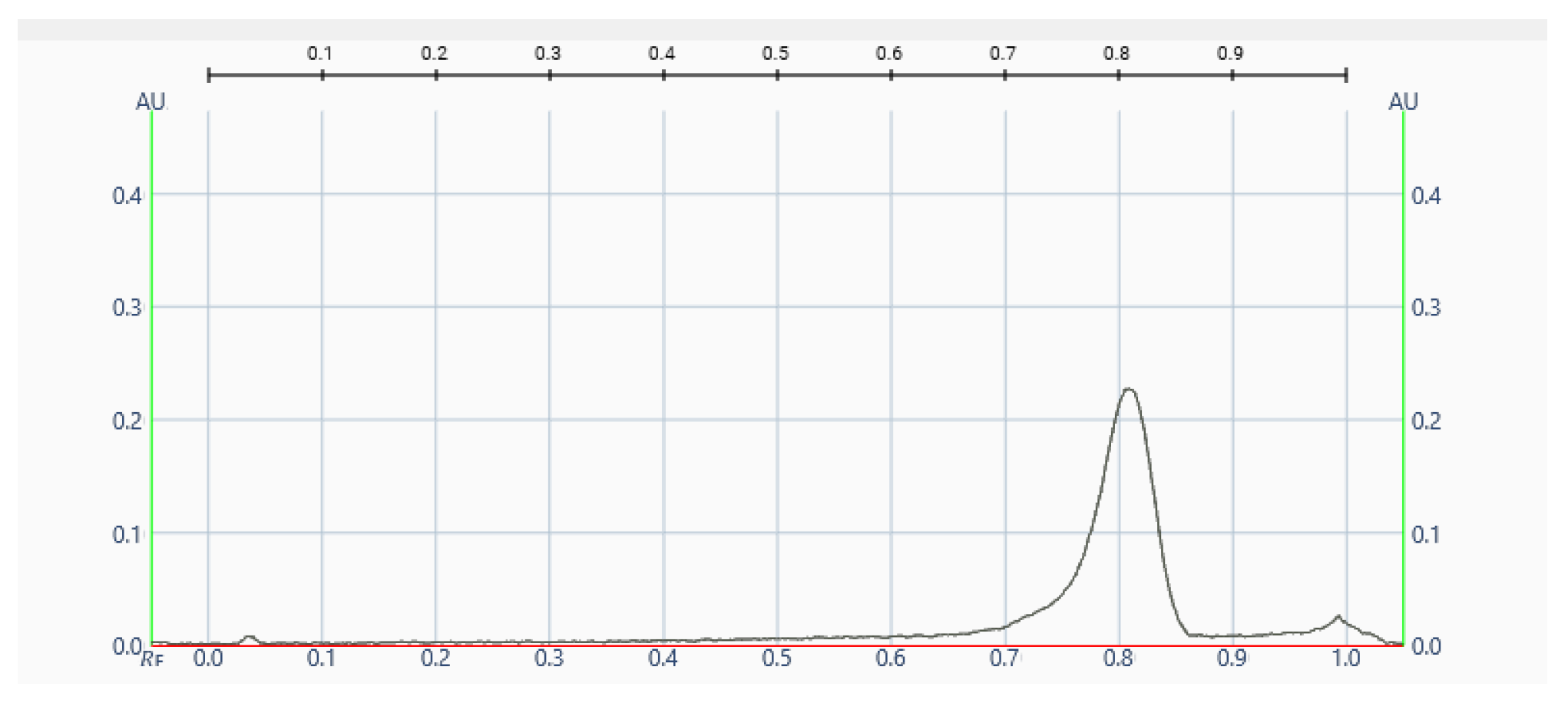
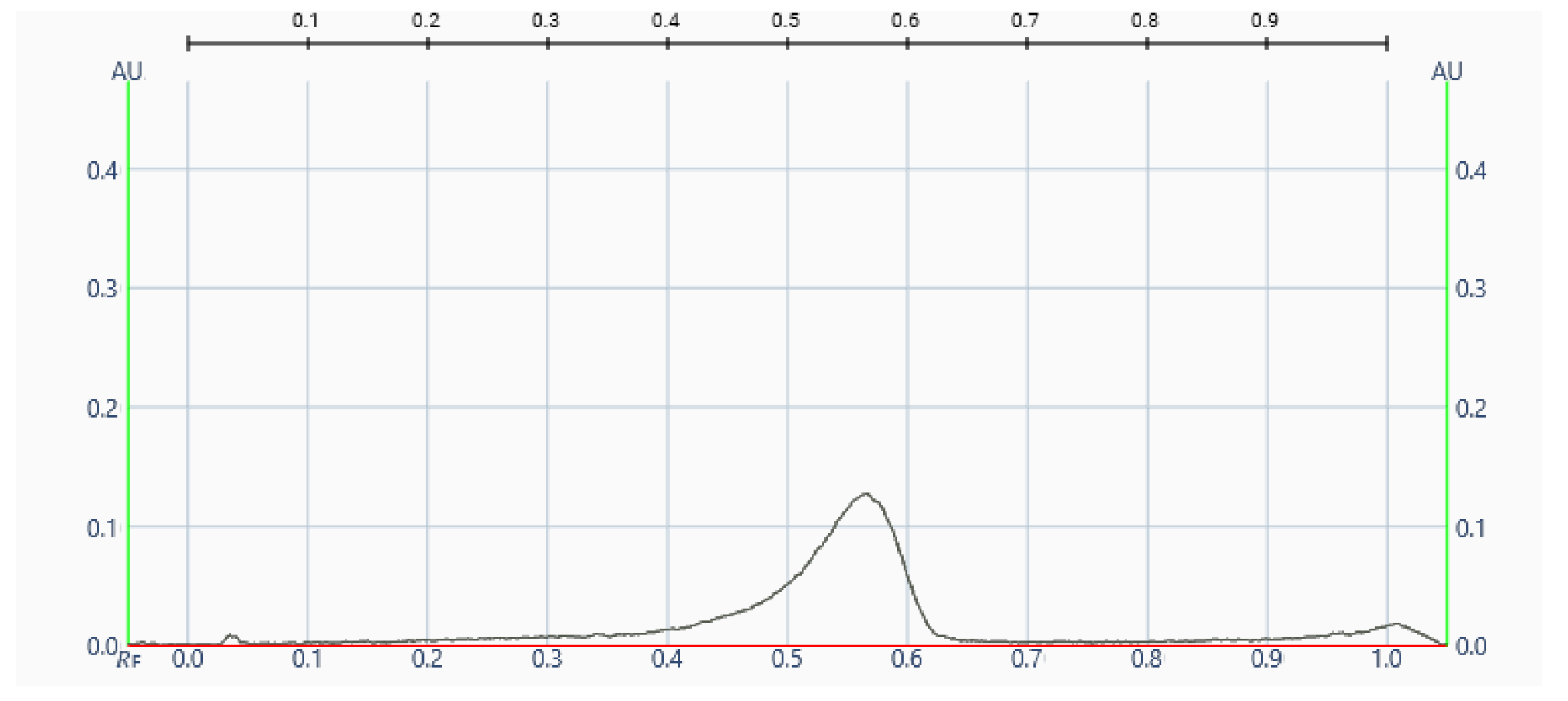
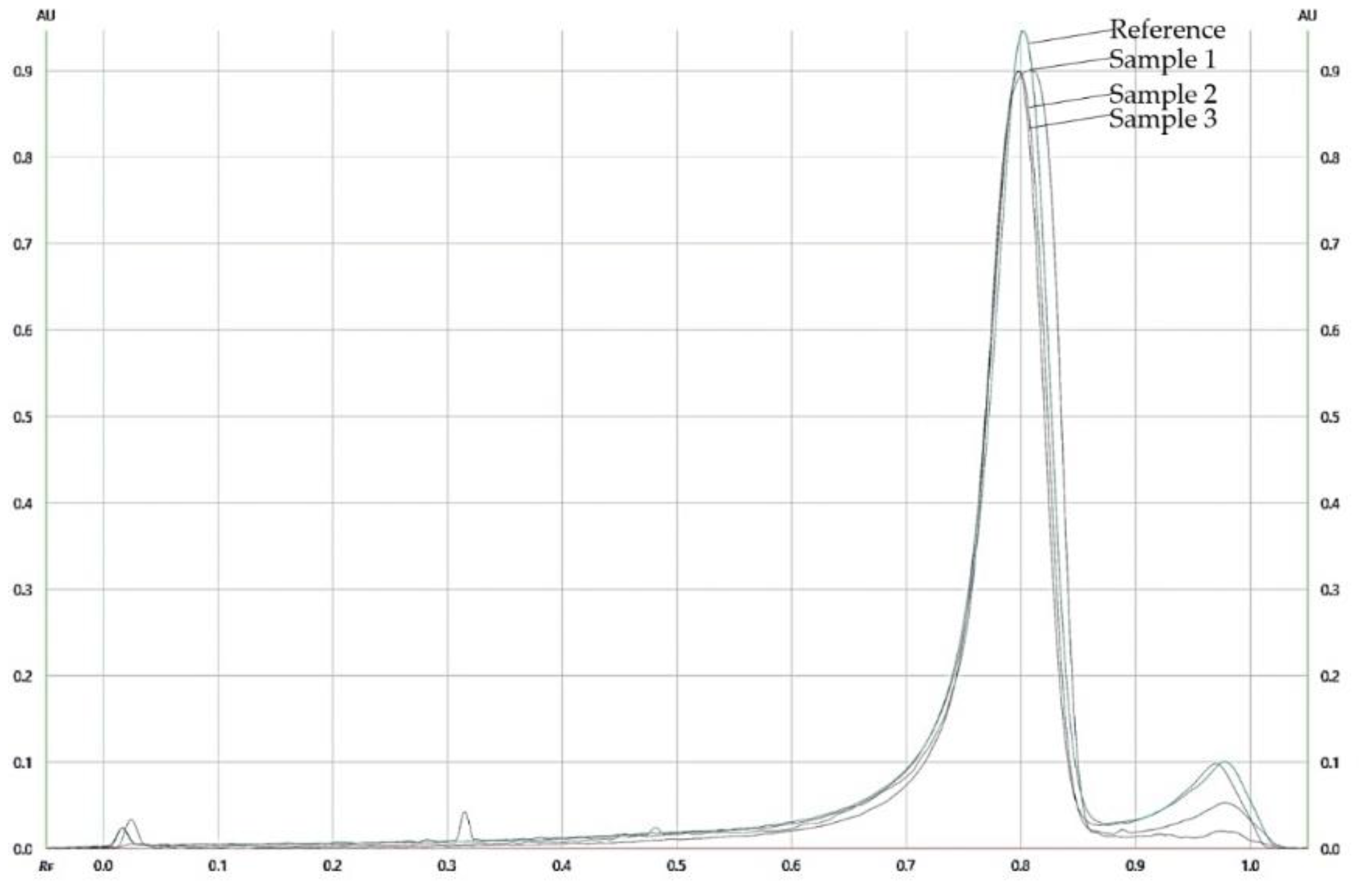

| Conc. (μg·band−1) | Conc. Found (μg·band−1) ± SD | Recovery % | Coefficient of Variation (CV %) |
|---|---|---|---|
| Meloxicam | |||
| 1 | 0.997 ± 0.001 | 99,73 | 0.10 |
| 0.6 | 0.601 ± 0.003 | 100,17 | 0.48 |
| 0.3 | 0.302 ± 0.004 | 100,61 | 1.23 |
| Piroxicam | |||
| 1 | 0.998 ± 0.001 | 99,75 | 0.08 |
| 0.6 | 0.601 ± 0.002 | 100,22 | 0.39 |
| 0.3 | 0.302 ± 0.004 | 100,78 | 1.31 |
| Conc. (μg·band−1) | Intraday Precision | Interday Precision | ||||
|---|---|---|---|---|---|---|
| Conc. Found (μg·band−1) ± SD | Standart Error | CV % | Conc. Found (μg·band−1) ± SD | Standart Error | CV % | |
| Meloxicam | ||||||
| 1 | 0.997 ± 0.001 | 0.001 | 0.10 | 0.997 ± 0.001 | 0.001 | 0.11 |
| 0.6 | 0.600 ± 0.002 | 0.001 | 0.39 | 0.605 ± 0.002 | 0.001 | 0.40 |
| 0.3 | 0.301 ± 0.003 | 0.001 | 1.03 | 0.302 ± 0.003 | 0.001 | 1.04 |
| Piroxicam | ||||||
| 1 | 0.998 ± 0.002 | 0.001 | 0.07 | 0.997 ± 0.001 | 0.001 | 0.09 |
| 0.6 | 0.601 ± 0.003 | 0.001 | 0.38 | 0.601 ± 0.002 | 0.001 | 0.37 |
| 0.3 | 0.301 ± 0.003 | 0.001 | 0.91 | 0.301 ± 0.003 | 0.001 | 0.92 |
| Classical TLC | HPTLC | |
|---|---|---|
| Sample application | Manual | Automatic |
| Mobile phase quantity | The quantity of the mobile phase varies in different methods. Normally, it is around 50 mL. | 10 mL |
| Development | In the chamber (all operations are performed manually). | Automatic |
| Time for development | Much more time is required. In these techniques, the average front needs to be 12–16 cm. | Much faster than TLC |
| Drying | The plate must be removed manually from the chamber and put in a specific place for drying. | Automatic |
| Safety | All operations are performed manually. The researcher is exposed to toxic solvents and evaporations. | Much safer than TLC |
| Purpose of the Proposed Method | Technique | Mobile Phase Composition | Detection Wave Length | LD | LQ | Ref. |
|---|---|---|---|---|---|---|
| Determination of piroxicam | HPTLC | Toluene/acetic acid (8:2 v/v) | 360 nm | The LD was presented in 40 ng. | The LQ was presented in 150 ng. | [22] |
| Comparison of the methods for determination of piroxicam | HPTLC | Chloroform/96% acetic acid (9:1 v/v) | 280 nm | Not presented | Not presented | [23] |
| Determination of piroxicam and degradation products | TLC | Ethyl acetate/toluene/butylamine (2:2:1, v/v/v) | 360 nm | 0.07 μg per spot | 0.20 μg per spot | [24] |
| Determination of piroxicam in biological material | TLC | Ethyl acetate/toluene/butylamine (2:2:1, v/v/v) | 360 nm | 0.07 μg per spot (in methanol)0.10 μg per spot (in acet one) | 0.21 μg per spot (in methanol)0.32 μg per spot (in acet one) | [25] |
| Determination of meloxicam | TLC | Ethyl acetate/toluene/butylamine (2:2:1, v/v/v) | 297 nm | 0.96 μg per spot | 2.90 μg per spot | [26] |
Publisher’s Note: MDPI stays neutral with regard to jurisdictional claims in published maps and institutional affiliations. |
© 2022 by the authors. Licensee MDPI, Basel, Switzerland. This article is an open access article distributed under the terms and conditions of the Creative Commons Attribution (CC BY) license (https://creativecommons.org/licenses/by/4.0/).
Share and Cite
Ivanova, S.; Todorova, V.; Dyankov, S.; Ivanov, K. High-Performance Thin-Layer Chromatography (HPTLC) Method for Identification of Meloxicam and Piroxicam. Processes 2022, 10, 394. https://doi.org/10.3390/pr10020394
Ivanova S, Todorova V, Dyankov S, Ivanov K. High-Performance Thin-Layer Chromatography (HPTLC) Method for Identification of Meloxicam and Piroxicam. Processes. 2022; 10(2):394. https://doi.org/10.3390/pr10020394
Chicago/Turabian StyleIvanova, Stanislava, Velislava Todorova, Stanislav Dyankov, and Kalin Ivanov. 2022. "High-Performance Thin-Layer Chromatography (HPTLC) Method for Identification of Meloxicam and Piroxicam" Processes 10, no. 2: 394. https://doi.org/10.3390/pr10020394
APA StyleIvanova, S., Todorova, V., Dyankov, S., & Ivanov, K. (2022). High-Performance Thin-Layer Chromatography (HPTLC) Method for Identification of Meloxicam and Piroxicam. Processes, 10(2), 394. https://doi.org/10.3390/pr10020394








